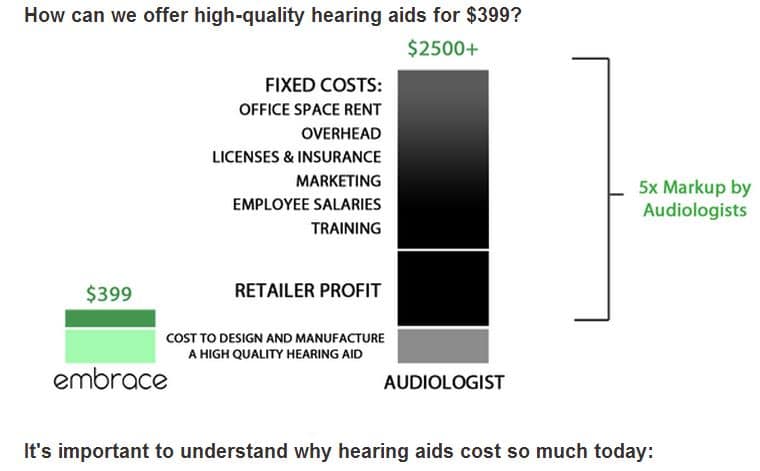“We don’t treat the product as a commodity other than the fact that the acquisition cost of the product is a line item.” Catherine Palmer PhD
Last week took issues with unmarked black boxes and the misuse of “markup” with reference to hearing aid sales. Today’s post continues the theme by introducing better boxes to get a handle on business costs and profits in dispensing practices that provide service as well as commodity.
Out, Out, Damn Black Box
Embrace Hearing –which has to be loving Hearing Economics for all the free publicity–employs a series of nefarious boxes to represent the current state of hearing aid dispensing.{{1}}[[1]]editor’s note: Embrace Hearing is not being singled out from the crowd of Internet sources for special treatment or abuse; they come up only because of their use of the black box diagram.[[1]]
Black boxes with mysterious, unknown content, portray a “broken system” of hearing aid dispensing in which hearing aids cost $2500+ because Audiologists use “5x” markups.
Figure 1 shows the Good Guys at Embrace fixing the broken system with dainty little green boxes–think money, think small –showing hearing aids “starting at” $399. No numbers in those boxes either, but a thin dark box implies low overhead and lower profit on wholesale instrument costs around $300, if the mint box is representative.
The Better Box Will Out
Figure 2 is Hearing Economic’s data-driven makeover of Figure 1. Perspective is altered, especially insofar as profit margins are concerned.
Data derives from a small sample of established private practices thought to be representative of the profession at present. Future posts will delve into the cost and profit structures of the practices which support the average values used for comparison in Figure 2.
Bona fides
Support for the notion that the chosen numbers and practices comprising Fig 2 are representative:
- Average sale price is $2139 in 2013, which compares reasonably well with average price in 2011 ($2118) derived from published sources. The very small increase over two years is consistent with slowing retail price increases since 2007.
- Average Expenses ($1376) + Net Profit ($40) = $1416. That’s right in the middle of the “retail markup” range ($1300-$1500/aid) calculated from published data.
- Average Cost of Goods ($723) is in line with historic wholesale pricing ($616, 2011) and modest predicted annual increases.{{2}}[[2]]See Fig 1 in previous post, projecting annual increases ranging from $23.71 to $51.29, for average and premium technology prices.[[2]]
Box Scores
Three differences between Figures are obvious:
- Average “retail” hearing aid Price is $2100+ not $2500+. That’s a 20% “markup” over reality. Score 1 for Figure 2.
- Average Cost of Goods is $723 (Fig 2), not $300 as suggested in Fig 1. But we already knew from a previous post that the comparison is apples to oranges. Score again for Figure 2.
- The 5x markup of Fig 1 is formulaically and numerically wrong. Even so, it only yields a x2 markup for the data in Fig 2. The same estimate was arrived at by other means in a previous post.
Fig 2 beats Fig 1, 3-0. Forget Fig 1 from here on out. The more interesting comparisons lie within Fig 2.
Who Nets the Profits?
- Online products cost about $300 and sell for $399 or more (Fig 2). The $99 difference defrays selling costs and leaves some net profit. Assuming Embrace nets $40 profit per hearing aid–the same as an Audiologist–the true percentage markup is 25%{{1}}[[1]]Markup = 100 – (Expenses/Selling Price) * 100.[[1]]
- By comparison, dispensing Audiology practices:
- Spend almost 2.5 times as much for product as their Internet counterparts.
- Expend >$1300 to order, fit and support each hearing aid sold, which is more than 20 times the selling expenses of Internet competitors.
- Average $40/aid net profit after product and services costs–a true percentage markup of <2%.
More Questions than Answers
Why should consumers fork out that extra $1300-$1500 for dispensing services and support when they can get the product directly for $399? Do consumers care whether Internet sellers make large profits and Audiologists make small profits? Should they care? Why should Audiologists slave for tiny net profits that leave them little margin to pay off school loans and weather unexpected economic shifts? What exactly are Audiologists spending that $1300-$1500 gross revenue on? Is their approach economically sensible? Future posts in this series will approach those questions by showing readers the numbers that underlie Figure 2.
From an Economic view, if the market for hearing devices is highly elastic–which is likely for low-cost Internet instruments–the Internet sellers win hands down. That’s because small reductions in already-low Price prompt proportionally higher percentages of Quantity sold when Demand is elastic. At any markup, especially a 25% markup, net profits are bound to be high. Expect more Internet ads.
(Editor’s note: this is Part 12 in the multi-year Hearing Aid Pricing series. Click here for Part 11 or Part 13).
title image courtesy of social capital markets








